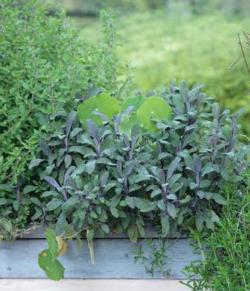Herbs: tough, attractive, practical
-
by Barbara J. Euser
 Herbs are among the easiest plants to grow
Herbs are among the easiest plants to growThe medieval Chateaudun in north central France dates from the twelfth century. In the fifteenth century, it was home to Jean de Dunois, comrade-in-arms of Joan of Arc. A medicinal herb garden lies to the side of the central courtyard, in the shadow of the tall, circular tower called the donjon. Its square plots are edged in neatly trimmed boxwood. Inside the perimeter of each plot, a number of herbs grow in less orderly profusion.
Although France and Marin County are miles apart, the two share similar Mediterranean climates that herbs adore. This includes full sun, dry summers, and a tolerance for poor soil. For this reason, there are a number of species that have been grown for centuries at Chateaudun that also flourish in Marin. Many have rich histories and medicinal properties that have benefited generations of people.
Anise (Pimpinella anisum) is an annual whose first growth is a clump of bright green roundish leaves. A stem with feathery leaves shoots up from the clump. Clusters of white flowers appear at stem tips in summer. After about four months, licorice-flavored seeds will be ready to harvest. The feathery leaves can be used in salads and the seeds in baked goods. Medicinally, the seeds were used to aid digestion and sweeten bad breath.
Borage (Borago officinalis) is an annual that provides good drought-tolerant groundcover. Its bristly leaves have a cucumber flavor. Use small tender leaves in salads or steam larger leaves as greens. Its star-shaped blue flowers can be used as an edible garnish. Medicinally, leaves were supposed to relieve melancholy. Also reputed to bring courage, borage was added to the final stirrup cup of those departing to fight in the Crusades.
Chamomile (Matricaria recutita) is an annual with daisy-like flowers and finely cut foliage. It prefers full sun and moderate water. Chamomile tea has been used since medieval times to cure headaches and relieve stress. More recently, Beatrix Potter had Peter Rabbit's mother give him chamomile tea after his stressful misadventures in Mr. McGregor's garden.
French tarragon (Artemesia dracunculus) is a sprawling perennial with shiny, dark green, aromatic leaves. It prefers full sun and little water. Leaves are used in cooking meats and in sauces and sprigs may be added to white wine vinegar to create tarragon vinegar.
Sorrel is a perennial with long arrow-shaped leaves. Common sorrel (Rumex acetosa) grows to three feet tall whereas French sorrel (Rumex scutatus) grows only eighteen inches tall. Both species taste like tangy spinach, though French sorrel is milder and with more lemon flavor. Sorrel leaves can be used to make soup, eaten in salads, or as greens. Sorrel is more heat tolerant than spinach and produces throughout the growing season.
Sage (Salvia officinalis) is the shrubby perennial sage used for culinary and medicinal purposes. Its aromatic wrinkled leaves are grayish-green on top and white and fuzzy underneath. Often used in stuffing or in sauces, sage may also be added to salads. Sage tea was a traditional spring tonic - a mild laxative helping to clean the system of toxins built up in the body over the winter months. With its double meaning, sage is an emblem of age and wisdom. An adage says: "A man will live to aye (old age)/Who eats sage in May."
Lovage (Levisticum officinale) is native to the eastern Mediterranean region. This perennial can be grown from seeds planted in the fall. Plants may reach three feet tall and wide. Its divided, glossy green leaves can be used in salads and added to soups and stews. Its greenish yellow flowers will yield seeds in the fall that are valued for their celery-like flavor as an addition to homemade breads and cakes.
Lemon balm (Melissa officinalis) is a perennial plant growing about two feet tall and eighteen inches wide. Its prolific seeds easily self-sow. The Greek word for bee is "Melissa," and bees certainly find it attractive. It is prized for its lemon-scented foliage, which may be added to cold drinks, fruit salads, and fish dishes. Medicinally, it was used to make tea given to patients suffering from colds or fevers.
These plants we love in our gardens today have a rich history. They have been planted by gardeners for centuries and used for medicinal as well as culinary purposes. Whether we use these plants in our kitchens or just enjoy them in our gardens, we can appreciate their long and useful heritage.
edited by Marie Narlock and Anne Wick

